Staying Ahead of the Curve: Risk Assessment in Threat Modeling
According to Gartner, “risk assessment is a critical component of threat modeling, which involves identifying potential threats and vulnerabilities in software and systems”. Risk assessment involves evaluating the likelihood and impact of each identified threat in order to prioritize the implementation of security controls and measures. By conducting a thorough risk assessment, businesses can better understand their security posture and identify areas that require additional attention. This can help prevent potential security breaches and reduce the impact of any incidents that do occur. In today’s rapidly evolving threat landscape, risk assessment is more critical than ever, as businesses must stay ahead of emerging threats and vulnerabilities to protect their critical assets. Ultimately, a risk assessment should be an integral part of any effective threat modeling strategy.

The components of a threat model encompass a definition of the subject to be modeled, assumptions that can be validated or questioned as the threat landscape evolves, potential threats to the system, measures to mitigate each threat, and a method for validating the model and threats, as well as verifying the efficacy of the implemented actions.
The approach to threat modeling varies based on the criticality of the classified information assets being identified and characterized. Nevertheless, any technology-dependent business process can benefit from it. The scope of threats confronting a particular system or method can be narrowed down and scrutinized using threat modeling. This eliminates ambiguity about potential hazards and how to safeguard against them and equips IT teams with the necessary information to secure the system well before any impending threat.
Advantages
- Aligning stakeholders:
During the system design review, all stakeholders are present and can discuss the system design. Any disputes regarding the expected functionality of the system can arise and be addressed. Often, there are divergent interpretations of critical system processes among individuals. However, these differences can be reconciled through the use of Threat Modeling.
- System analysis:
A Threat Model presents a comprehensive system overview, with the possibility of detailed analysis as required. This method of top-down analysis ensures that all connections within the system are understood. Unlike a standard penetration test, which merely identifies vulnerabilities, Threat Modeling facilitates consensus on addressing security concerns. It aligns the security of the system with the organization’s security policy.
- Flaw prevention and risk control
It is assumed that Threat Modeling is performed during the design phase. By conducting Threat Modeling early in the process, potential flaws that could lead to vulnerabilities can be identified. Prevention is more cost-effective than rectifying issues after the fact. Moreover, Threat Modeling aids in determining the level of risk associated with the identified flaws. As a result, it enables the prioritization of mitigating measures and effective risk management in alignment with the organization’s policies.
- Development priorities:
Once risk is identified and quantified, prioritizing development efforts to address the most significant risks becomes easier. Risk analysis becomes a critical consideration when planning system development. A Threat Model dataflow diagram can readily reveal design weaknesses or points where the system may be vulnerable to exploitation. Such areas can be targeted for penetration testing, resulting in more targeted and efficient testing, particularly in larger systems, which ultimately translates into cost savings.
Threat modeling is a practical approach to analyzing the risks associated with a product and determining the security measures required to manage those risks. Moreover, a comprehensive threat model can be instrumental in performing a security assessment. At Auxin, we evaluate a product’s threat model to determine the optimal allocation of resources during a security assessment. For instance, if a particular mitigation is used to safeguard a critical asset, we can allocate more effort to testing that comfort based on the product’s threat model, which guides such decisions.
Conclusion
Typically, attackers focus on acquiring, controlling, or disrupting specific assets. Security organizations should consider these assets and prioritize risks based on the identified threats when assessing risks. This prioritization should be integrated into new features at the earliest possible stage so that security and functionality are proactive in driving development. For more knowledge read our blogs on our website Auxin.io.






